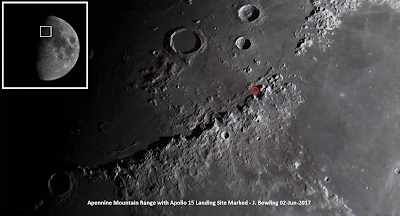Lunar 100 Target 4 Apennine Mountain Range
Lunar 100 Target 4 Apennine Mountain Range

Image Details: 127SLT w/ 1.5x Barlow and ASI290MC, stacked from one minute of video
Full sized image
Somewhere around 3.75 billion years ago, during the Late Heavy Bombardment, a large asteroid or protoplanet hit the northern hemisphere of the moon. The impact caused an enormous impact crater known as the Imbrium Basin, bordered by high steep walls of rock.
Later lava partially filled in the basin, and hardened to a smooth dark surface known as Mare Imbrium (sea of showers). The Mare Imbrium The Apennine mountains are part of the remainder of the high crater edges. Even though partially buried by lava, the highest peaks are 5 km / 3.1 m high.
The mountain range is about 600 km / 370 m long. It is easily visible with binoculars and is a pretty stunning sight when the terminator line is near it, bringing the 3 dimensional structure into view.
The Apollo 15 mission landed here - the position is marked on the photograph.
Later lava partially filled in the basin, and hardened to a smooth dark surface known as Mare Imbrium (sea of showers). The Mare Imbrium The Apennine mountains are part of the remainder of the high crater edges. Even though partially buried by lava, the highest peaks are 5 km / 3.1 m high.
The mountain range is about 600 km / 370 m long. It is easily visible with binoculars and is a pretty stunning sight when the terminator line is near it, bringing the 3 dimensional structure into view.
The Apollo 15 mission landed here - the position is marked on the photograph.
